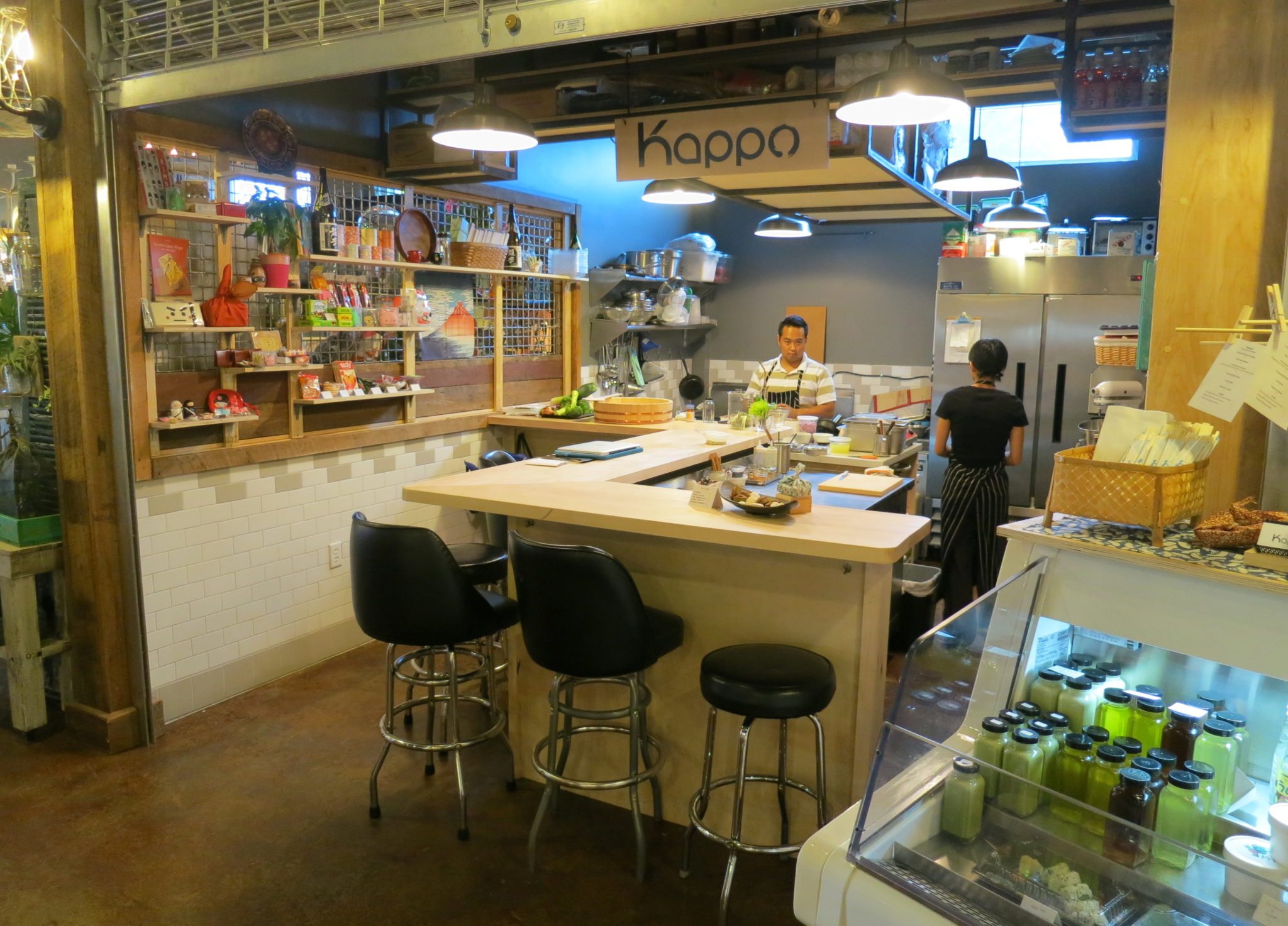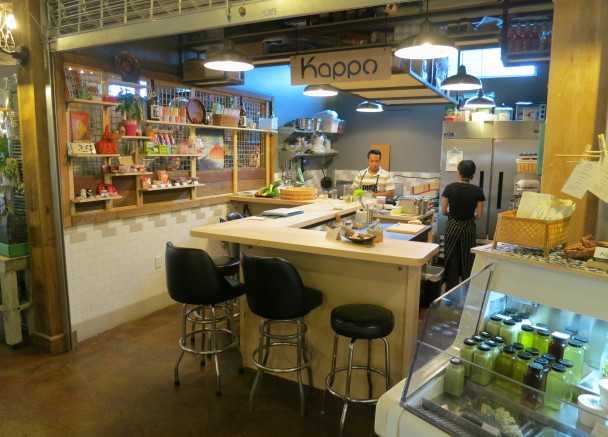Michael Cuglietta is a Florida writer. His work has appeared in NOON, The Gettysburg Review, Tampa Review and Passages North. He is the author of the chapbook, Vertigo (Gertrude Press, 2014). He can be reached at [email protected].
In the kitchen, there are three sinks. Under the sinks, in a grey plastic tub, are two industrial size bottles of pink liquid. One is soap. The other sanitizing solution.
“The first sink gets two and a half pumps of soap.” Jen, Kappo’s pastry chef and one woman wait staff, demonstrates. “You want the water as hot as you can stand it.” She runs her hand under the steaming stream.
The middle sink is for rinsing. It’s filled with fresh water. The last sink is the sanitizing sink. It gets two full pumps of the pink solution. From the sanitizing sink, everything goes to the drying rack. During the lunch rush, Lo, whose role at Kappo is similar to that of sous chef, catches me drying dishes with a towel.
“You’re wasting time.” He takes the towel away. “Get back to the ginger. Let the dishes air dry.”
After showing me how to properly clean the dishes, Jen puts a hotel pan of thinly sliced, pickled ginger in my station. The moisture needs to be pressed out of the ginger, which is served alongside each piece of sushi.
She scoops up a handful and molds the slices into a wedge, roughly the size and shape of an unshelled Brazil nut. Over a second hotel pan, this one with a slotted tray in the center, she presses the wedge into her palm, using her index and middle fingers to extract the liquid. Then she gives it a good squeeze before laying it on the slotted tray.
“Now, let me see you do one.” She steps aside.
There are ginger presses, which would remove the liquid in minutes. But that’s not how it’s done in a Japanese kitchen. Pressing the ginger is the first exercise for a sushi chef-in-training.
I am not a sushi chef-in-training. I am a tourist. A volunteer. A fool who has spent too much time watching the Food Network.
“You’re going to be sore tomorrow,” Mark, the head chef and sushi master, says as he molds a piece of salmon over a mound of rice, the same size and shape as the mound of ginger in my hand.
It takes me close to an hour to press all the ginger and transfer it to the second hotel pan. When I’m done, I empty the liquid from the bottom of the pan and start over. The ginger has to be pressed three times. That’s nearly three hours to complete a task, which a machine could finish in an effortless instant. “Wax on. Wax off, Daniel-san.”
The next morning, when I try and pick our kitten up by the scruff of her neck, I’m unable to lift her. The muscles in my hand, my sushi muscles, are too sore.
Once the restaurant gets busy, my main task is making sure there is one load of dishes in the drying rack and another soaking in the sanitizing sink at all times.
Kappo has a wide assortment of dishes. “White people,” Mark tells me, “serve food on plain dishes. In Japanese cuisine, we must find a dish that best compliments the food.”
I am the one white guy in an Asian kitchen. A fact, which is pointed out many times throughout the day. Not because of any bias. But because, in the freewheeling, adrenaline-fueled language of the kitchen, there is no room for political correctness.
Once a rack of dishes is dry, I pile them onto a serving tray. The hardest part is finding the proper home for each dish. Kappo is a seven seat sushi stand. Mark slices the fish and builds the sushi in front of the customers. The dishes are kept on shelves behind him. When unloading a tray, we have to stand back-to-back. He works with a 24 inch chef’s knife.
“Behind you,” I say, afraid I’ll bump him, causing him to damage a delicate cut of fish or, worse, take a finger off.
By the time I find a home for all the clean dishes, a new pile of dirty ones is waiting next to the sink. This means, I have to transfer the dishes from the sanitizing sink to the drying rack. The dishes in the rinsing sink must be moved to the sanitizing sink. The soapy dishes will go to the rinsing sink. Then I have to scrub the dirty ones. But, first, I must change the water, which has turned brown.
“Stop what you’re doing,” Lo says, rescuing me from the relentless assembly line of kitchenware. “I need you to shuck these.” From the lowboy, he pulls out fifteen oysters. Two for each customer and one for the chef to sample. I open one. Lo spoons clam foam on top. There are seven handspun, clay plates set up in the station. Each plate has two piles of shaved sea salt on it. Lo sets the first oyster on top of one of the piles of salt.
I open a second oyster. Using a pair of surgical tongs, Lo lays the meat of a live sea urchin on top. Then he adds a dab of foie gras custard. He places it on the second pile of salt. One plate is ready to be served. Lo waits to build the second plate. I can feel his breath on my neck as he watches me struggle with the next oyster.
The customers are sitting in front of an empty counter, ready for their next course, the oyster course.
At the beginning of the day, Lo taught me how to shuck an oyster. The trick, he showed me, is to slowly ease it apart. In a moment of desperation, I try and jam the knife in with a quick, stabbing motion. The oyster flies out of my hand, slides across the counter and lands on the floor.
The oyster was the only thing separating my hand from the knife. It sinks into my palm. I hold it between my legs and hop up and down. The words coming out of my mouth shouldn’t be said in front of customers. It’s not professional.
After checking my hand to make sure there is no blood, Lo tells me it’s time for shots. At 10am, when the liquor store opened, I was sent to buy a handle bottle of Jameson. It sits in my station, next to the pickled ginger. When Lo calls for a shot, I’m to stop whatever it is I’m doing.
I line up eleven glasses, one for each customer and one for Mark, Lo, Jen and myself. I’m operating on a headful of whiskey. My hand is sore from the stabbing and the day is not even half over. In an effort to slow things down, I fill the glasses only halfway and pass them out.
“What’s this?” Mark points his knife at me. “I don’t know how you white people do it. But, at Kappo, we fill the glasses all the way to the top.”
The customers, all seven of them as white as me, laugh as I walk around with the bottle, topping them off.
“Kanpai.” We clank glasses. Then shoot them back.
As soon as my glass touches the counter, Lo pours me a refill. “Because you tried to get away with a half shot,” he forces the glass into my hand, “you have to do another.”
A woman approaches the counter. She’s middle aged and wearing a business suit. She studies the menu for a long time before asking Mark if he can make a California roll.
I’ve seen this scene play out many times. If Mark is busy, which is most of the time, he will shout, “No sushi rolls,” without taking his eyes off his cutting board. At which point, if Jen is able to break away, she will take the time to explain how the restaurant works.
She serves the dessert, one scoop of lime basil ice cream, which I watched her make that morning, with two tea cakes, one matcha, the other red bean. Then she walks over to the woman.
She tells her Kappo is an Omakase restaurant. Omakase is Japanese for “chef’s choice.” The sushi is served one piece at a time, to insure the proper temperature and texture of the rice. The menu changes daily, sometimes even hourly. They don’t take reservations. To get a seat, you must arrive early, put your name on a list and wait.
“We’re all booked for today.” She consults her IPad. “But, if you’d like, I could put your name on the list for tomorrow.”
The woman takes another look at the menu. She lifts her glasses off her face and squints. “What about a spicy tuna roll? Could I get a spicy tuna roll, to take back to the office?”
I understand the woman’s confusion. Most sushi restaurants in America specialize in over-the-top Westernized rolls. That is to say, they’ll deep fry just about any protein (softshell crab, shrimp, tempura battered chicken) combine it with a fat (usually mayo or cream cheese, sometimes avocado) and roll it in seaweed and rice. Always with the rice on the outside, since everyone knows Americans are afraid of seaweed.
The sushi served at Kappo is about subtlety. They get big flavors but they do it in the simplest way, using traditional Japanese ingredients. Their focus is not on how many ingredients they can stuff into a roll. Their focus is on the rice. They might add a dab of freshly grated wasabi or lightly brush the fish in the house soy sauce. But the rice is always the star of the show. The other ingredients, including the fish, are the supporting cast.
Once the woman is gone, Lo calls for a final round of shots. The customers settle their bills. Just as soon as they stand up, seven new people, who’ve been waiting for over an hour, take their places.
Jen sets everyone up with chopsticks and a glass of water. Per Lo’s request, I start each of them out with a shot of Jameson.
“Let’s toast to Mike,” Mark raises his glass, “our helper for the day.” Everyone holds their glasses up and we say, “Kanpai.”
I ask if anyone would like to see a menu. They laugh at me. Of course they don’t need to see a menu. They’ve all eaten here before. They know, whatever Kappo is serving, they are having.
Kappo (Facebook | Instagram) is located in East End Market in the heart of the Audubon Park Garden District [GMap].



ha ha, I was wondering what the “white guy” was doing there. 🙂